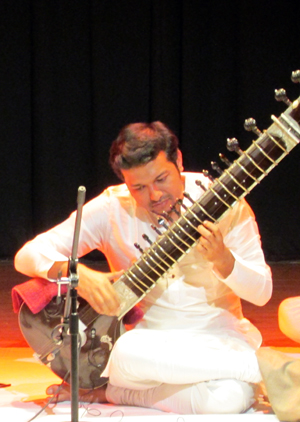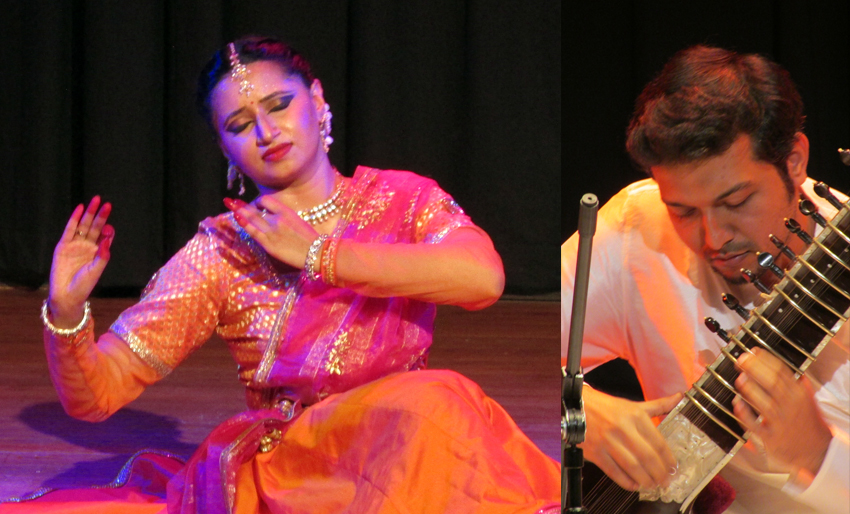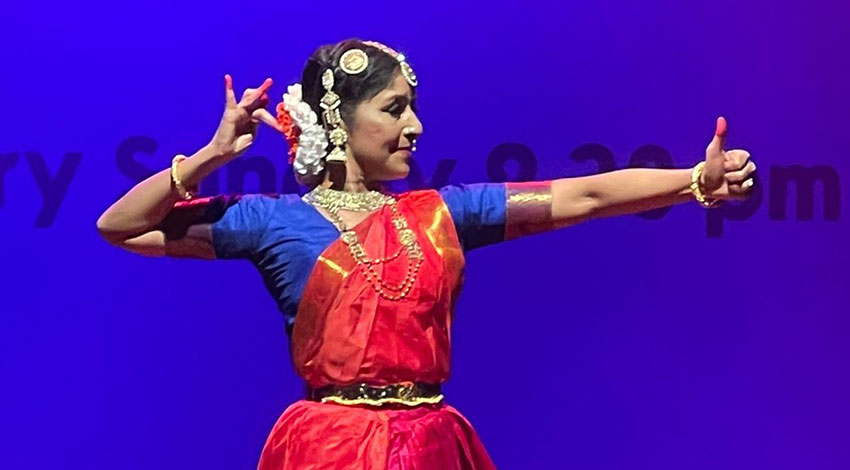In order to encourage the artists from the young generation in classical Hindustani and Carnatic music and dance, Raza Foundation has been presenting the talented musicians and dancers in their monthly series of Arambha. They have been presenting the artists at Alliance Francaise of Delhi in their auditorium. Sometimes they present them twice also. Once at Alliance Francaise and at Triveni Kala Sangam. Of late they have extended the presentation to Raipur and Mandala in Madhya Pradesh in order to get the artists known in these regions. The series has received welcome support from the audience everywhere.
Sitar recital by Soumitra Thakur

Soumitra Thakur is currently studying under Pandit Kushla Das of the Mahiat gharana. He was initiated in learning the sitar by his uncle Shri Prashant Thakur of Bishnupur Gharana. Soumitra has participated in many music conferences all over India including the prestigious Dover Lane Music Conference, Kolkata where during the competition he won 1st prize in 2010. Since then he has never looked back and has been performing in several conferences.
On Wednesday the 6th November, in the beginning, the young sitar player Soumitra Thakur, a disciple of Kushal Das, presented seasonal raga Hemant. That he is a versatile and seasoned player was at once noticed by his elaborate aalap and in particular the meend that he often resorted to that created sweetness in his rendering. He played at leisure giving the form to raga which was melodious and appealing to ears.
Accompanied by renowned tabla accompanist Pandit Durjay Bhuamik, he was in form and during the jod and jhala his command over the instrument was obvious and praiseworthy. The speed with which he played with complete ease and minus any difficulty was admirable. Here is a young artist whose riyaz demands praise. Listening to his sitar one felt optimistic that classical instrumental music is in safe hands. Durjay Bhuamik gave him excellent support. There was no overshadowing his sitar playing. Instead one found that both of them had praiseworthy rapport. At times on account of the speed with which Soumitra was playing one was apprehensive and a little tense. But both of them played harmoniously.
Soumitra has a bright future.
Kathak by Varsha Dasgupta
A disciple of the dancing duo Abhimanyu and Vidha Lal, in turn, disciples of Guru Geetanjali Lal of Jaipur Gharana, young and possessing an attractive stage presence Varsha Dasgupta performed Kathak with zest and confidence. There was a sparkle and finesse in her execution of movements and chakkars.

She began with Shivastuti in Hamsdhwani raga. Choreographed by Vidha Lal with inputs by Abhimanyu and music composed by Guru Geetanjali Lal, Varsha delineated the iconic form of Lord Shiva in his great glory. Playing Damaru .the drum in one of his hands, dancing vigorously Tandava, Varsha evoked the mood effectively. The ornaments of the serpent, the skin of Vyaghra, the tiger, were depicted graphically. IN between the number was enriched with the mnemonic syllables, to which Varsha displayed her command over the footwork.
The use of Kavit in praise of Shiva like Jatajuta matha Ganga khalaka kata, the Ganges flowing from the Jata of Lord Shiva and crescent moon adorning his forehead, wearing the garland of the skull, he is the Lord of Parvati enriched the prayer. The recitation of kavit lent delectable sound texture. The flourishes of pirouettes were flawless.
Varsha switched over to the main presentation. She began with Thaat, the graceful movements of the wrist, the arms and moving to an attractive stance. The Jaipur gharana thaats often show speed and end with graceful poses. Presenting the pure dance aspect, nritta, in vilambit laya and teen tala displayed her taiyyari. The recitation of the mnemonic syllables and its execution to the accompaniment of percussion instruments was flawless. The speed with which she executed the number was noteworthy for energetic movements. And when the number ended, the final pose was graceful.
Kathak dancers revel in their presentation of layakari. Spontaneous improvisation while executing footwork is often a delight to watch. Varsha has at this stage mastered it under the careful supervision of Guru Geetanjali Lal.
The musical interlude by Salman khan on pakhavaj was competent with variations he brought to bear upon his playing. In Kathak performance often the accompanists are given the opportunity to display their virtuosity. It also gives relief to the dancer to prepare for the next numbers.
[adrotate group=”9″]
Varsha performed the usual parans with elan. The incorporation of various chakkars, covering the stage were delightful. They also were indicative of Varsha’s practice and hence the ease with which she executed.
The finale with anther abhinaya number Radha Kanhu in Malkaunsa raga and Rupak tala was in imaginative composition. Almost parallel to the familiar Ardhanarishwara of Shankaracharya, this traditional composition, attempts at the unity of Radha and Krishna in one body. Holding the hast mudra of showing the crown of a peacock feather and other hand holding the corner of the veil, ghungat and walking gracefully forward the image of Radha Krishna was beautifully evoked. Holding in one arm the flute, Radha attempting to snatch it away, their playing the game of throwing a ball and catching it effortlessly, but Radha misses it et al were danced suggestively.
Radha awaiting Krishna prepares a garland of flowers. She looks in different directions for Krishna and the needle picks her when she is inattentive. When Krishna arrives she garlands him, applies chandan paste and both of them dance joyously.
Krishna is described as spending half of the time grazing the cows, and Radha half of the time looking for Krishna. Abhimanyu Lal composed these stanzas to further enhance the unity of Radha and Krishna. At times Radha suggests wearing the long-sleeved blouse and Krishna pitambar, Radha earrings and Krishna crown, and when together they are seen one sees Krishna holding flute in one arm and with other he embraces Radha.
The joyous playing with sticks brought to the rendering of Raas abundance. Varsha was in her element and concluded the number with flourish holding the hand gesture of Mukut and of ghunghat, suggesting the unity of Radha and Krishna.
[adrotate group=”9″]
Varsha concluded her recital with this number and did not resort to usual jugalbandhi with a percussionist. As she had already displayed her competence while dancing nritta pieces and therefore it was not necessary to indulge in the repartee. That was a good ending.
The vocalist Mohammed Nizam rendered the song melodiously. On Tabla was the ace percussionist Aman Ali, on pakhavaj Salman Khan, on sarangi Ahasan Ali and on padhant, recitation of bols, mnemonic syllables Nikhil Parihar. They gave Varsha excellent support. Varsha proved that she has arrived on the Kathak scene.










